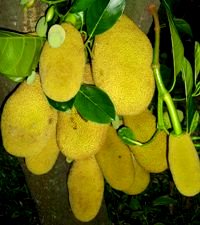For the enterprising crop farmers who wish to engage in growing jackfruit, this how-to guide is offered as a general reference.
The cultural practices will also find application in other farm crops.
Cultural Practices for Jackfruit
1. Plant Propagation
The use of seeds is generally preferred because vegetative propagation is quite difficult.
However, trees may not exhibit the characteristics of the parent plant, take a longer time to start flowering, and are generally tall.
The seeds should be collected from healthy, mature plants which are prolific producers of fruits with desirable characteristics.
Only large seeds are used. Immediately after extraction from the fruit, the seeds are washed in water to remove the slimy coating around the seeds.
The horny part of the pericarp is also removed to hasten germination.

As a general rule, the seeds are sown immediately without drying because they are recalcitrant (click to read Sexual Propagation: Orthodox vs. Recalcitrant Seeds).
If not possible, however, the seeds can be stored in air-tight plastic containers at 20 C to maintain their viability for about 3 months.
In sowing, the seeds are laid flat or with their hilum facing downward. Germination should begin within 10 days.
It is expected that 80-100% of the seeds will have germinated within 35 to 40 days after sowing.
Growing jackfruit can also be started through vegetative propagation using stem cuttings and by air layering or marcotting.
However, special techniques are necessary, including the use of rooting hormones at the right concentrations.
The Forkert method or patch budding, as well as cleft grafting and wedge grafting, likewise proved successful.
In Thailand, suckle grafting is extensively applied in growing jackfruit.
It is a form of inarching in which young potted rootstocks are decapitated and inserted in twigs of the mother trees.
SCUC (2006) also recommends veneer grafting and epicotyl grafting, also called stone grafting and softwood grafting (click here to read the procedures in grafting).
2. Weeding and Mulching
Ring weeding is practiced to keep the immediate periphery of the tree free of weeds.
This operation is a regular necessity in growing jackfruit at least during the first 3 to 4 years after planting.
The weeds can be piled around the tree to serve as mulch which will conserve moisture and prevent the germination of weed seeds.
3. Pruning
The height of jackfruit, especially those raised from seed, can be regulated by cutting the main trunk about 2-3 meters from the ground.
Early cutback of the main trunk can also be done to induce the production of branches, allowing 4 or 5 branches to develop which are evenly distributed when viewed from the top.
Properly trained, jackfruit grows with an open center which allows better light penetration.
Weak, dead, diseased, and overlapping branches should be removed.
This is to promote light penetration and air movement and to prevent the build-up of insect pests and disease pathogen populations.
Branches are also removed if they hinder access to the fruits during wrapping and harvesting.
4. Intercropping
It is desirable that the spaces between the rows of the jackfruit trees are cultivated and used for the production of either annual or perennial intercrops or both.
Examples of such intercrops are citrus, banana, pineapple, corn, peanut (groundnut), and other pulses, spices, and vegetables.
This will maximize farm productivity in addition to the benefits of proper weed control management.
If not, leguminous cover crops can be seeded.
5. Insect Pest and Disease Control
It is important that one who engages in growing jackfruit should also be familiar with pests and diseases that affect the crop.
The two major pests of jackfruit are the shoot and fruit borer (Diaphania caesalis) and the brown bud weevil (Ochyromera artocarpi).
Caterpillars of the shoot borer tunnel into buds, young shoots, and fruit.
The grubs of the bud weevil bore into young buds and fruits while the adults feed on the leaves.
To prevent damage, the fruits are wrapped in plastic bags when still young.
Fallen, overripe, and damaged fruits should be collected and buried underground.
Blossom rot, also called fruit rot and stem rot, is a serious disease caused by the fungus Rhizopus artocarpi.
It may lead to 15-32% crop losses.
The disease affects the inflorescences or the tips of the flowering shoots. The inflorescences turn black, rot and drop.
Another disease is the pink disease, also called pink limb blight, caused by the fungus Corticium salmonicolor.
This disease infects many farm crops, including rubber, citrus, mango, durian, coffee, and cacao.
Control measures include thorough collection and disposal of the affected parts and fallen fruits.
6. Harvesting
Young fruits can be harvested for vegetables 2-3 months after the fruit set or when the seeds are hardened.
For mature fruits, the selection is based on the following indices:
(1) hollow sound when the fruit is tapped;
(2) change in the color of the skin from pale green to greenish-yellow or brownish-yellow;
(3) emission of a strong aroma;
and (4) flattening of the spines with wider spaces.
The stalk (peduncle) of the fruit should be cut with a sharp knife and the fruit is gently lowered to the ground.
References
Agriculture and Fisheries Information Service (AFIS). n.d. Jackfruit. Department of Agriculture. Retrieved October 12, 2010, from http://www.da.gov.ph/tips/jackfruit.pdf.
Morton, J. 1987. Jackfruit. In: Fruits of warm climates. pp. 58-64. Retrieved October 12, 2010, from http://www.hort.purdue.edu/newcrop/morton/jackfruit_ars.html (updated 10/12/110).
Quisumbing, Q. 1978. Medicinal Plants of the Philippines. Katha Publishing Co., Inc. pp. 228-230.
Southampton Center for Underutilized Crops (SCUC). 2006. Jackfruit Artocarpus heterophyllus, Field Manual for Extension Workers and Farmers, SCUC, Southampton, UK. Retrieved October 10, 2010, from http://www.scribd.com/doc/20042510/Jackfruit-Manual-pdf.
Verheij, E.W.M. and R.E. Coronel (eds.). 1992. Edible fruits and nuts. Plant Resources of South-East Asia N0. 2. Bogor, Indonesia: Prosea Foundation. pp. 86-91.

What is the blue substance placed on the Peduncle of the cut jackfruit?
Is it possible for jackfruit leaves to grow roots